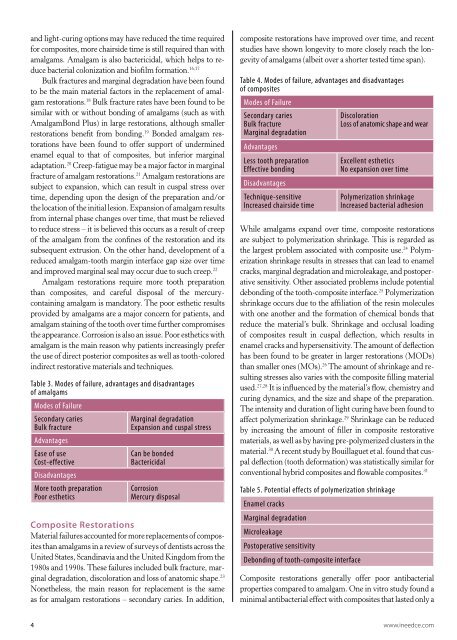The Properties and Selection of Posterior Direct ... - IneedCE.com
The Properties and Selection of Posterior Direct ... - IneedCE.com
The Properties and Selection of Posterior Direct ... - IneedCE.com
You also want an ePaper? Increase the reach of your titles
YUMPU automatically turns print PDFs into web optimized ePapers that Google loves.
<strong>and</strong> light-curing options may have reduced the time required<br />
for <strong>com</strong>posites, more chairside time is still required than with<br />
amalgams. Amalgam is also bactericidal, which helps to reduce<br />
bacterial colonization <strong>and</strong> bi<strong>of</strong>ilm formation. 16,17<br />
Bulk fractures <strong>and</strong> marginal degradation have been found<br />
to be the main material factors in the replacement <strong>of</strong> amalgam<br />
restorations. 18 Bulk fracture rates have been found to be<br />
similar with or without bonding <strong>of</strong> amalgams (such as with<br />
AmalgamBond Plus) in large restorations, although smaller<br />
restorations benefit from bonding. 19 Bonded amalgam restorations<br />
have been found to <strong>of</strong>fer support <strong>of</strong> undermined<br />
enamel equal to that <strong>of</strong> <strong>com</strong>posites, but inferior marginal<br />
adaptation. 20 Creep-fatigue may be a major factor in marginal<br />
fracture <strong>of</strong> amalgam restorations. 21 Amalgam restorations are<br />
subject to expansion, which can result in cuspal stress over<br />
time, depending upon the design <strong>of</strong> the preparation <strong>and</strong>/or<br />
the location <strong>of</strong> the initial lesion. Expansion <strong>of</strong> amalgam results<br />
from internal phase changes over time, that must be relieved<br />
to reduce stress – it is believed this occurs as a result <strong>of</strong> creep<br />
<strong>of</strong> the amalgam from the confines <strong>of</strong> the restoration <strong>and</strong> its<br />
subsequent extrusion. On the other h<strong>and</strong>, development <strong>of</strong> a<br />
reduced amalgam-tooth margin interface gap size over time<br />
<strong>and</strong> improved marginal seal may occur due to such creep. 22<br />
Amalgam restorations require more tooth preparation<br />
than <strong>com</strong>posites, <strong>and</strong> careful disposal <strong>of</strong> the mercurycontaining<br />
amalgam is m<strong>and</strong>atory. <strong>The</strong> poor esthetic results<br />
provided by amalgams are a major concern for patients, <strong>and</strong><br />
amalgam staining <strong>of</strong> the tooth over time further <strong>com</strong>promises<br />
the appearance. Corrosion is also an issue. Poor esthetics with<br />
amalgam is the main reason why patients increasingly prefer<br />
the use <strong>of</strong> direct posterior <strong>com</strong>posites as well as tooth-colored<br />
indirect restorative materials <strong>and</strong> techniques.<br />
Table 3. Modes <strong>of</strong> failure, advantages <strong>and</strong> disadvantages<br />
<strong>of</strong> amalgams<br />
Modes <strong>of</strong> Failure<br />
Secondary caries<br />
Bulk fracture<br />
Advantages<br />
Ease <strong>of</strong> use<br />
Cost-effective<br />
Disadvantages<br />
More tooth preparation<br />
Poor esthetics<br />
Marginal degradation<br />
Expansion <strong>and</strong> cuspal stress<br />
Can be bonded<br />
Bactericidal<br />
Corrosion<br />
Mercury disposal<br />
Composite Restorations<br />
Material failures accounted for more replacements <strong>of</strong> <strong>com</strong>posites<br />
than amalgams in a review <strong>of</strong> surveys <strong>of</strong> dentists across the<br />
United States, Sc<strong>and</strong>inavia <strong>and</strong> the United Kingdom from the<br />
1980s <strong>and</strong> 1990s. <strong>The</strong>se failures included bulk fracture, marginal<br />
degradation, discoloration <strong>and</strong> loss <strong>of</strong> anatomic shape. 23<br />
Nonetheless, the main reason for replacement is the same<br />
as for amalgam restorations – secondary caries. In addition,<br />
<strong>com</strong>posite restorations have improved over time, <strong>and</strong> recent<br />
studies have shown longevity to more closely reach the longevity<br />
<strong>of</strong> amalgams (albeit over a shorter tested time span).<br />
Table 4. Modes <strong>of</strong> failure, advantages <strong>and</strong> disadvantages<br />
<strong>of</strong> <strong>com</strong>posites<br />
Modes <strong>of</strong> Failure<br />
Secondary caries<br />
Bulk fracture<br />
Marginal degradation<br />
Advantages<br />
Less tooth preparation<br />
Effective bonding<br />
Disadvantages<br />
Technique-sensitive<br />
Increased chairside time<br />
Discoloration<br />
Loss <strong>of</strong> anatomic shape <strong>and</strong> wear<br />
Excellent esthetics<br />
No expansion over time<br />
Polymerization shrinkage<br />
Increased bacterial adhesion<br />
While amalgams exp<strong>and</strong> over time, <strong>com</strong>posite restorations<br />
are subject to polymerization shrinkage. This is regarded as<br />
the largest problem associated with <strong>com</strong>posite use. 24 Polymerization<br />
shrinkage results in stresses that can lead to enamel<br />
cracks, marginal degradation <strong>and</strong> microleakage, <strong>and</strong> postoperative<br />
sensitivity. Other associated problems include potential<br />
debonding <strong>of</strong> the tooth-<strong>com</strong>posite interface. 25 Polymerization<br />
shrinkage occurs due to the affiliation <strong>of</strong> the resin molecules<br />
with one another <strong>and</strong> the formation <strong>of</strong> chemical bonds that<br />
reduce the material’s bulk. Shrinkage <strong>and</strong> occlusal loading<br />
<strong>of</strong> <strong>com</strong>posites result in cuspal deflection, which results in<br />
enamel cracks <strong>and</strong> hypersensitivity. <strong>The</strong> amount <strong>of</strong> deflection<br />
has been found to be greater in larger restorations (MODs)<br />
than smaller ones (MOs). 26 <strong>The</strong> amount <strong>of</strong> shrinkage <strong>and</strong> resulting<br />
stresses also varies with the <strong>com</strong>posite filling material<br />
used. 27,28 It is influenced by the material’s flow, chemistry <strong>and</strong><br />
curing dynamics, <strong>and</strong> the size <strong>and</strong> shape <strong>of</strong> the preparation.<br />
<strong>The</strong> intensity <strong>and</strong> duration <strong>of</strong> light curing have been found to<br />
affect polymerization shrinkage. 29 Shrinkage can be reduced<br />
by increasing the amount <strong>of</strong> filler in <strong>com</strong>posite restorative<br />
materials, as well as by having pre-polymerized clusters in the<br />
material. 30 A recent study by Bouillaguet et al. found that cuspal<br />
deflection (tooth deformation) was statistically similar for<br />
conventional hybrid <strong>com</strong>posites <strong>and</strong> flowable <strong>com</strong>posites. 31<br />
Table 5. Potential effects <strong>of</strong> polymerization shrinkage<br />
Enamel cracks<br />
Marginal degradation<br />
Microleakage<br />
Postoperative sensitivity<br />
Debonding <strong>of</strong> tooth-<strong>com</strong>posite interface<br />
Composite restorations generally <strong>of</strong>fer poor antibacterial<br />
properties <strong>com</strong>pared to amalgam. One in vitro study found a<br />
minimal antibacterial effect with <strong>com</strong>posites that lasted only a<br />
4 www.ineedce.<strong>com</strong>
















